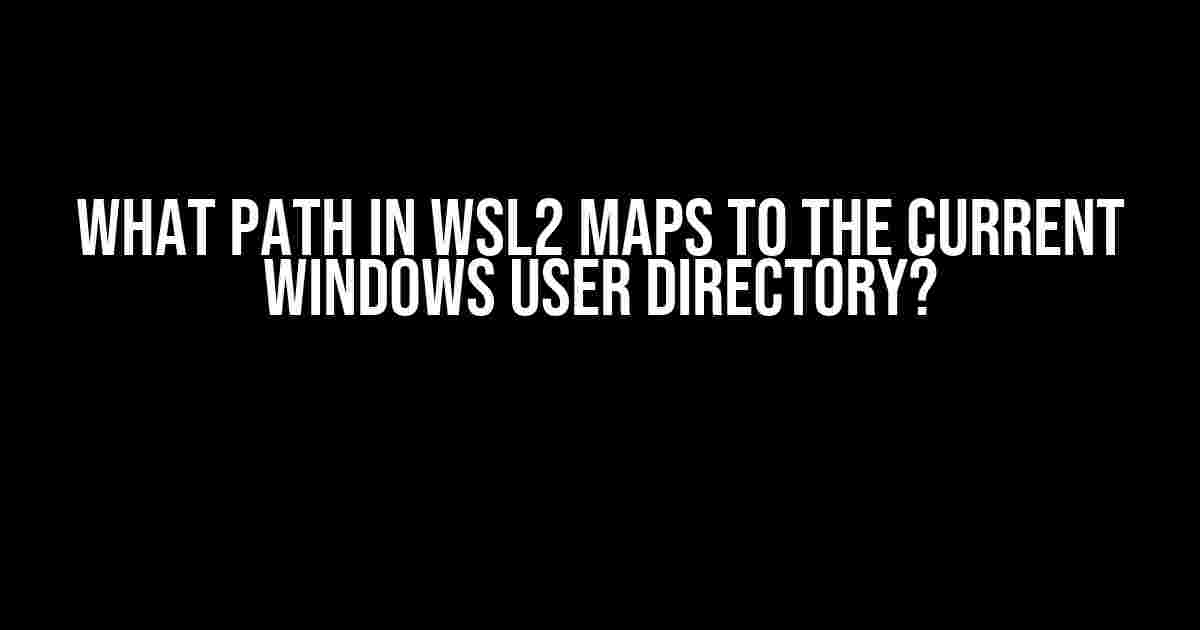Are you a Windows user who’s recently fallen in love with the Linux world, courtesy of WSL2? Well, congratulations on making the switch! However, as you delve deeper into the world of Linux, you might find yourself wondering: what path in WSL2 maps to the current Windows user directory?
The Mysterious Case of WSL2 and Windows User Directories
WSL2, or Windows Subsystem for Linux 2, is an incredible feature that allows you to run a Linux distribution directly on top of Windows. It’s like having the best of both worlds! But, as you navigate through the Linux terminal, you might find yourself struggling to access files and folders from your Windows user directory.
This is because WSL2 creates a separate file system for Linux, which is isolated from the Windows file system. This isolation is what makes WSL2 so secure and efficient, but it also means you need to navigate through a different set of directories to access your Windows files.
So, What’s the Magic Path?
The answer lies in the /mnt directory. Yes, you read that right! The /mnt directory in WSL2 is where you’ll find all the magic happen. This directory is a mount point for your Windows file system, which means it provides a gateway to access your Windows files and folders from within Linux.
Here’s the specific path you’re looking for:
/mnt/c/Users/your_username
Replace your_username with your actual Windows username, and voilà! You’ll be taken to your Windows user directory, where you can access all your files and folders.
A Step-by-Step Guide to Accessing Your Windows User Directory
Just in case you’re a visual learner or need a refresher, here’s a step-by-step guide to accessing your Windows user directory in WSL2:
- Open your WSL2 terminal. You can do this by searching for “WSL” in the Start menu or by using the Windows key + R to open the Run dialog box and typing
wsl. - Once you’re in the terminal, type
cd /mntand press Enter. This will take you to the/mntdirectory. - Type
cd cand press Enter. This will take you to the/mnt/cdirectory, which is where your Windows file system is mounted. - Finally, type
cd Users/your_usernameand press Enter. Replace your_username with your actual Windows username. - You should now be in your Windows user directory, where you can access all your files and folders.
What Can You Do with This Knowledge?
Now that you know the secret path to your Windows user directory, the possibilities are endless! Here are a few ideas to get you started:
- Access and edit Windows files and folders directly from within Linux.
- Use Linux tools and commands to manipulate Windows files and folders.
- Share files and folders between your Windows and Linux environments.
- Use Linux scripting to automate tasks that involve Windows files and folders.
Troubleshooting Common Issues
As with any new technology, you might encounter some issues when trying to access your Windows user directory in WSL2. Here are some common issues and their solutions:
| Issue | Solution |
|---|---|
| Permission denied error | Try using sudo before your command to run it with administrator privileges. |
| File not found error | Make sure you’re using the correct path and filename. You can use the ls command to list the files and folders in the current directory. |
| Windows user directory not found | Make sure you’re using the correct username in the path. You can find your username in the Windows Start menu or by typing whoami in the Command Prompt. |
Conclusion
And there you have it! You now know the secret path to your Windows user directory in WSL2. With this knowledge, you can unlock a whole new world of possibilities, from accessing and editing Windows files to automating tasks with Linux scripting.
Remember, the key to success lies in the /mnt directory and the correct path to your Windows user directory. So, go ahead and explore the possibilities of WSL2 and Linux!
Frequently Asked Question
WSL2 can be a bit mysterious, but don’t worry, we’ve got answers!
What path in WSL2 maps to the current Windows user directory?
The path `/mnt/c/Users/YourUsername` maps to the current Windows user directory in WSL2. Just replace “YourUsername” with your actual Windows username.
How do I navigate to the Windows user directory from WSL2?
You can navigate to the Windows user directory from WSL2 by typing `cd /mnt/c/Users/YourUsername` in the terminal. Boom! You’re there!
Why does WSL2 use a different file system than Windows?
WSL2 uses a virtual file system to provide a Linux-like environment, which is separate from the Windows file system. This allows Linux applications to run natively on Windows without modification.
Can I access Windows files from WSL2?
Yes, you can access Windows files from WSL2. The Windows file system is mounted at `/mnt/c` (or `/mnt/` for other drives). You can navigate to these paths to access your Windows files.
Is it possible to share files between WSL2 and Windows?
Yes, you can share files between WSL2 and Windows. Since WSL2 has access to the Windows file system, you can create files in Windows and access them from WSL2, and vice versa.
